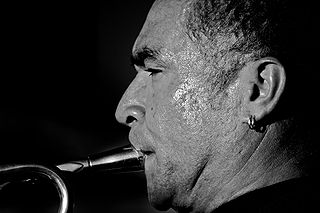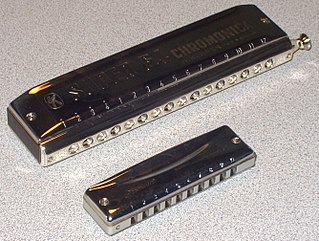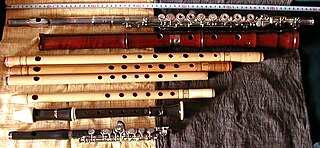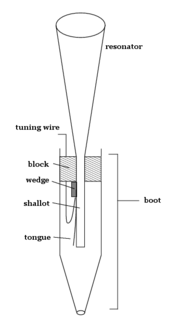External links
- A PDF with pictures explaining the technique
- Video of Marco Mazzini explaining the slap tongue in the clarinet
| General | |
|---|---|
| Wind instruments | |
| Piano | |
| Bowed string instruments | |
| Guitar | |
| Harp | |
| Percussion | |
| Human voice | |
| Related articles | |
In music, the term slap tonguing refers to a musician playing a single-reed instrument such as a clarinet or a saxophone employing a technique to produce a popping sound along with the note.
The sound is created as a result of the release of suction in the mouth and the popping sound that the reed produces which amplifies as it travels through the horn.
To create this effect, lay your tongue against a lot of the reed. Gently push upward so that the tip and rail of the reed is closed. Get rid of as much air in the oral cavity as you can and seal off the lip so that you have an airtight fit. The tongue is quickly released in a downward motion. When you release the tongue downward, you also drop your jaw and open your mouth in a "popping" motion. This is all done very quickly. Do not pull the tongue back towards your throat. It needs to pop downward away from the roof of the mouth to get the most volume, do not blow air through the horn and do not inhale when you release your tongue.
The first recorded appearance was by Stump Evans, the C melody saxophone player in the King Oliver band. Other famous players who used the technique were Rudy Wiedoeft, Coleman Hawkins and Fess Williams. Contemporary exponents include Sam Newsome.

Bass ( BAYSS) (also called bottom end) describes tones of low (also called "deep") frequency, pitch and range from 16 to 256 Hz (C0 to middle C4) and bass instruments that produce tones in the low-pitched range C2-C4. They belong to different families of instruments and can cover a wide range of musical roles. Since producing low pitches usually requires a long air column or string, and for stringed instruments, a large hollow body, the string and wind bass instruments are usually the largest instruments in their families or instrument classes.

The clarinet is a type of single-reed woodwind instrument. Like many wind instruments, clarinets are made in several different sizes, each having its own range of pitches. All have a nearly-cylindrical bore and a flared bell, and utilize a mouthpiece with a single reed. A person who plays a clarinet is called a clarinetist.

Embouchure or lipping is the use of the lips, facial muscles, tongue, and teeth in playing a wind instrument. This includes shaping the lips to the mouthpiece of a woodwind instrument or the mouthpiece of a brass instrument. The word is of French origin and is related to the root bouche, 'mouth'. Proper embouchure allows instrumentalists to play their instrument at its full range with a full, clear tone and without strain or damage to their muscles.

The harmonica, also known as a French harp or mouth organ, is a free reed wind instrument used worldwide in many musical genres, notably in blues, American folk music, classical music, jazz, country, and rock. The many types of harmonica include diatonic, chromatic, tremolo, octave, orchestral, and bass versions. A harmonica is played by using the mouth to direct air into or out of one holes along a mouthpiece. Behind each hole is a chamber containing at least one reed. The most common is the diatonic Richter-tuned with ten air passages and twenty reeds, often called the blues harp. A harmonica reed is a flat, elongated spring typically made of brass, stainless steel, or bronze, which is secured at one end over a slot that serves as an airway. When the free end is made to vibrate by the player's air, it alternately blocks and unblocks the airway to produce sound.

Woodwind instruments are a family of musical instruments within the more general category of wind instruments. Common examples include flute, clarinet, oboe, bassoon, and saxophone. There are two main types of woodwind instruments: flutes and reed instruments. The main distinction between these instruments and other wind instruments is the way in which they produce sound. All woodwinds produce sound by splitting the air blown into them on a sharp edge, such as a reed or a fipple. Despite the name, a woodwind may be made of any material, not just wood. Common examples include brass, silver, cane, as well as other metals such as gold and platinum. The saxophone, for example, though made of brass, is considered a woodwind because it requires a reed to produce sound. Occasionally, woodwinds are made of earthen materials, especially ocarinas.

An aerophone is a musical instrument that produces sound primarily by causing a body of air to vibrate, without the use of strings or membranes, and without the vibration of the instrument itself adding considerably to the sound.

Slapping and popping are ways to produce percussive sounds on a stringed instrument. It is primarily used on the double bass or bass guitar. Slapping on bass guitar involves using the edge of one's knuckle, where it is particularly bony, to quickly strike the string against the fretboard. On bass guitars, this is commonly done with the thumb, while on double bass, the edge of the hand or index finger may be used. Popping refers to pulling the string away from the fretboard and quickly releasing it so it snaps back against the fretboard. On bass guitar, the two techniques are commonly used together in alternation, though either may be used separately.
Overblowing is the manipulation of supplied air through a wind instrument that causes the sounded pitch to jump to a higher one without a fingering change or the operation of a slide. Overblowing may involve a change in the air pressure, in the point at which the air is directed, or in the resonance characteristics of the chamber formed by the mouth and throat of the player.

A double reed is a type of reed used to produce sound in various wind instruments. In contrast with a single reed instrument, where the instrument is played by channeling air against one piece of cane which vibrates against the mouthpiece and creates a sound, a double reed features two pieces of cane vibrating against each other. The term double reeds can also refer collectively to the class of instruments which use double reeds.
A multiphonic is an extended technique on a monophonic musical instrument in which several notes are produced at once. This includes wind, reed, and brass instruments, as well as the human voice. Multiphonic-like sounds on string instruments, both bowed and hammered, have also been called multiphonics, for lack of better terminology and scarcity of research.

A single-reed instrument is a woodwind instrument that uses only one reed to produce sound. The very earliest single-reed instruments were documented in ancient Egypt, as well as the Middle East, Greece, and the Roman Empire. The earliest types of single-reed instruments used idioglottal reeds, where the vibrating reed is a tongue cut and shaped on the tube of cane. Much later, single-reed instruments started using heteroglottal reeds, where a reed is cut and separated from the tube of cane and attached to a mouthpiece of some sort. By contrast, in a double reed instrument, there is no mouthpiece; the two parts of the reed vibrate against one another. Reeds are traditionally made of cane and produce sound when air is blown across or through them. The type of instruments that use a single reed are clarinets and saxophone. The timbre of a single and double reed instrument is related to the harmonic series caused by the shape of the corpus. E.g. the clarinet is only including the odd harmonics due to air column modes canceling out the even harmonics. This may be compared to the timbre of a square wave.
Tonguing is a technique used with wind instruments to enunciate notes using the tongue on the palate or the reed or mouthpiece. A silent "tee" is made when the tongue strikes the reed or roof of the mouth causing a slight breach in the air flow through the instrument. If a more soft tone is desired, the syllable "da" is preferred. The technique also works for whistling. Tonguing also refers to articulation, which is how a musician begins the note and how the note is released For wind players, articulation is commonly spoken of in terms of tonguing because the tongue is used to stop and allow air to flow in the mouth. Tonguing does not apply to non wind instruments, but articulation does apply to all instruments.

A reed pipe is an organ pipe that is sounded by a vibrating brass strip known as a reed. Air under pressure is directed towards the reed, which vibrates at a specific pitch. This is in contrast to flue pipes, which contain no moving parts and produce sound solely through the vibration of air molecules. Reed pipes are common components of pipe organs.

The mouthpiece of a woodwind instrument is that part of the instrument which is placed partly in the player's mouth. Single-reed instruments, capped double-reed instruments, and fipple flutes have mouthpieces while exposed double-reed instruments and open flutes do not. The characteristics of a mouthpiece and reed can play a significant role on the sound of the instrument.
The Frenzel Maneuver is named after Hermann Frenzel. The maneuver was developed in 1938 and originally was taught to dive bomber pilots during World War II. The maneuver is used to equalize pressure in the middle ear. Today, the maneuver is also performed by scuba divers, free divers and by passengers on aircraft as they descend.
Reed aerophones is one of the categories of musical instruments found in the Hornbostel-Sachs system of musical instrument classification. In order to produce sound with these Aerophones the player's breath is directed against a lamella or pair of lamellae which periodically interrupt the airflow and cause the air to be set in motion.

A wind instrument is a musical instrument that contains some type of resonator in which a column of air is set into vibration by the player blowing into a mouthpiece set at or near the end of the resonator. The pitch of the vibration is determined by the length of the tube and by manual modifications of the effective length of the vibrating column of air. In the case of some wind instruments, sound is produced by blowing through a reed; others require buzzing into a metal mouthpiece, while yet others require the player to blow into a hole at an edge, which splits the air column and creates the sound.

Saxophone technique refers to the physical means of playing the saxophone. It includes how to hold the instrument, how the embouchure is formed and the airstream produced, tone production, hands and fingering positions, and a number of other aspects. Instrumental technique and corresponding pedagogy is a topic of much interest to musicians and teachers and therefore has been subjected to personal opinions and differences in approach. Over the course of the saxophone’s performance history, notable saxophonists have contributed much to the literature on saxophone technique.
The Lindeman-Sobel Approach to Artistic Wind Performance is an integrated musical approach that seeks to unite fingers, air stream, and rhythm relative to the notes on the page and the length of tube you are blowing through.